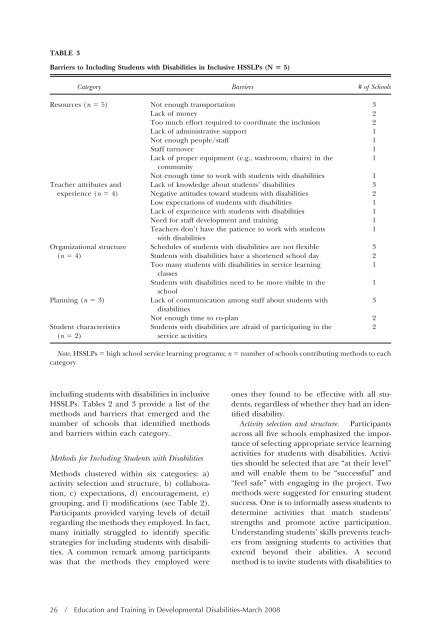Download the Journal (PDF) - Division on Autism and ...
Download the Journal (PDF) - Division on Autism and ...
Download the Journal (PDF) - Division on Autism and ...
You also want an ePaper? Increase the reach of your titles
YUMPU automatically turns print PDFs into web optimized ePapers that Google loves.
TABLE 3<br />
Barriers to Including Students with Disabilities in Inclusive HSSLPs (N 5)<br />
Category Barriers # of Schools<br />
Resources (n 5) Not enough transportati<strong>on</strong> 3<br />
Lack of m<strong>on</strong>ey 2<br />
Too much effort required to coordinate <str<strong>on</strong>g>the</str<strong>on</strong>g> inclusi<strong>on</strong> 2<br />
Lack of administrative support 1<br />
Not enough people/staff 1<br />
Staff turnover 1<br />
Lack of proper equipment (e.g., washroom, chairs) in <str<strong>on</strong>g>the</str<strong>on</strong>g><br />
community<br />
1<br />
Not enough time to work with students with disabilities 1<br />
Teacher attributes <strong>and</strong> Lack of knowledge about students’ disabilities 3<br />
experience (n 4) Negative attitudes toward students with disabilities 2<br />
Low expectati<strong>on</strong>s of students with disabilities 1<br />
Lack of experience with students with disabilities 1<br />
Need for staff development <strong>and</strong> training 1<br />
Teachers d<strong>on</strong>’t have <str<strong>on</strong>g>the</str<strong>on</strong>g> patience to work with students<br />
with disabilities<br />
1<br />
Organizati<strong>on</strong>al structure Schedules of students with disabilities are not flexible 3<br />
(n 4) Students with disabilities have a shortened school day 2<br />
Too many students with disabilities in service learning<br />
classes<br />
1<br />
Students with disabilities need to be more visible in <str<strong>on</strong>g>the</str<strong>on</strong>g><br />
school<br />
1<br />
Planning (n 3) Lack of communicati<strong>on</strong> am<strong>on</strong>g staff about students with<br />
disabilities<br />
3<br />
Not enough time to co-plan 2<br />
Student characteristics<br />
(n 2)<br />
including students with disabilities in inclusive<br />
HSSLPs. Tables 2 <strong>and</strong> 3 provide a list of <str<strong>on</strong>g>the</str<strong>on</strong>g><br />
methods <strong>and</strong> barriers that emerged <strong>and</strong> <str<strong>on</strong>g>the</str<strong>on</strong>g><br />
number of schools that identified methods<br />
<strong>and</strong> barriers within each category.<br />
Methods for Including Students with Disabilities<br />
Methods clustered within six categories: a)<br />
activity selecti<strong>on</strong> <strong>and</strong> structure, b) collaborati<strong>on</strong>,<br />
c) expectati<strong>on</strong>s, d) encouragement, e)<br />
grouping, <strong>and</strong> f) modificati<strong>on</strong>s (see Table 2).<br />
Participants provided varying levels of detail<br />
regarding <str<strong>on</strong>g>the</str<strong>on</strong>g> methods <str<strong>on</strong>g>the</str<strong>on</strong>g>y employed. In fact,<br />
many initially struggled to identify specific<br />
strategies for including students with disabilities.<br />
A comm<strong>on</strong> remark am<strong>on</strong>g participants<br />
was that <str<strong>on</strong>g>the</str<strong>on</strong>g> methods <str<strong>on</strong>g>the</str<strong>on</strong>g>y employed were<br />
Students with disabilities are afraid of participating in <str<strong>on</strong>g>the</str<strong>on</strong>g><br />
service activities<br />
Note. HSSLPs high school service learning programs; n number of schools c<strong>on</strong>tributing methods to each<br />
category<br />
26 / Educati<strong>on</strong> <strong>and</strong> Training in Developmental Disabilities-March 2008<br />
<strong>on</strong>es <str<strong>on</strong>g>the</str<strong>on</strong>g>y found to be effective with all students,<br />
regardless of whe<str<strong>on</strong>g>the</str<strong>on</strong>g>r <str<strong>on</strong>g>the</str<strong>on</strong>g>y had an identified<br />
disability.<br />
Activity selecti<strong>on</strong> <strong>and</strong> structure. Participants<br />
across all five schools emphasized <str<strong>on</strong>g>the</str<strong>on</strong>g> importance<br />
of selecting appropriate service learning<br />
activities for students with disabilities. Activities<br />
should be selected that are “at <str<strong>on</strong>g>the</str<strong>on</strong>g>ir level”<br />
<strong>and</strong> will enable <str<strong>on</strong>g>the</str<strong>on</strong>g>m to be “successful” <strong>and</strong><br />
“feel safe” with engaging in <str<strong>on</strong>g>the</str<strong>on</strong>g> project. Two<br />
methods were suggested for ensuring student<br />
success. One is to informally assess students to<br />
determine activities that match students’<br />
strengths <strong>and</strong> promote active participati<strong>on</strong>.<br />
Underst<strong>and</strong>ing students’ skills prevents teachers<br />
from assigning students to activities that<br />
extend bey<strong>on</strong>d <str<strong>on</strong>g>the</str<strong>on</strong>g>ir abilities. A sec<strong>on</strong>d<br />
method is to invite students with disabilities to<br />
2
















